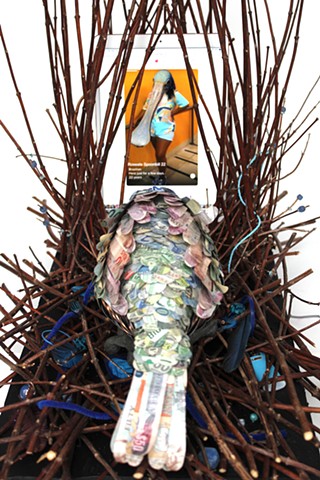Belonging
Tender
This piece is based on the Satin Bowerbird. These fascinating birds build complex bowers to attract mates. The males of the species construct the bowers, collecting shiny and colorful objects, usually blue, to decorate and entice the females. In the first seven years, the juvenile males look identical to the females. They go around visiting bowers, being wooed by other males, and learning how to do it all themselves when the time comes. Typically, the female of the species chooses a mate based on aesthetics and the quality of the courtship display. This is known as sexual selection and is different from natural selection. Over time, this changes the birds' genetics to favor the biological qualities that the females prefer, which are not necessarily the qualities that benefit the species as a whole.
Our courtship rituals are now digital. In the past, 'putting yourself out there' meant vulnerability, spontaneity, excitement, and a sense of risk. Now it seems to come with filters, face tuning, spell check, the delete button, feigned indifference, and limitless choices.
Tinder asks you for 'the best picture of yourself' when you sign up for an account. What do these photos say about a person? Aspirational phrases centered around self-worth, like 'live the best version of yourself,' are now standard messages on social media and imply that there are many versions, some better than others, and only one that is worth living. Is it self-worth… self-modification… self-commodification?
As we curate our online identities, we present a hybrid of who we think we are and how we’d like to be perceived. It is inherently self-promoting. We are both celebrating and selling our ego. The Internet is changing us. It amplifies the power we have to choose how we focus our attention, but it also leads us down rabbit holes.
